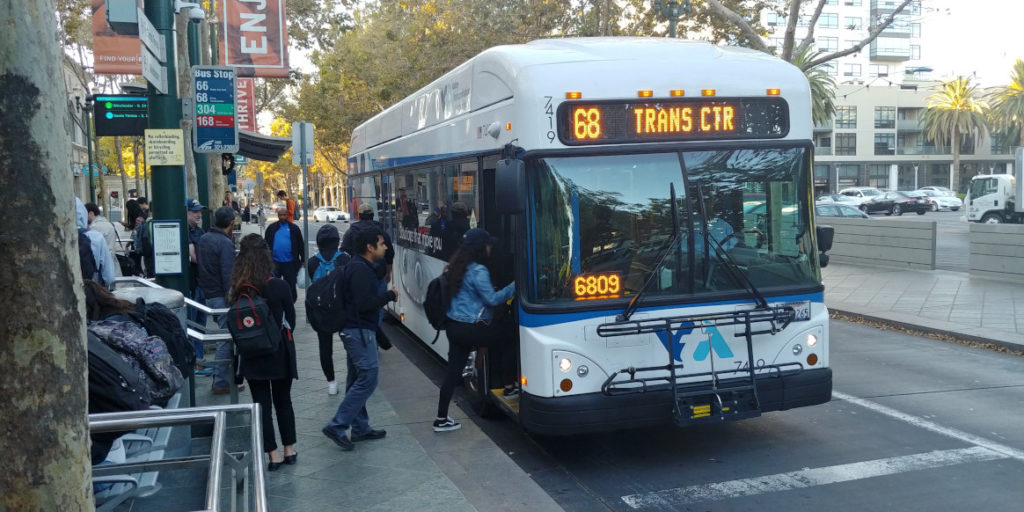
Table of Contents
- Background
- Know Before You Go
- How To Ride VTA Buses
- How To Ride VTA Light Rail
- Conclusion
Background
Are you visiting, recently moved to or started working in Silicon Valley? New to taking public transportation in the Valley? Taking a Santa Clara Valley Transportation Authority (VTA) bus or light rail train can be intimidating for someone riding public transit for the very first time.
This guide will detail the steps you need to make your first trip riding a VTA bus or light rail train as pleasant as possible. It will also detail how to make future trips equally as rewarding and pleasant for yourself – and fellow passengers.
A special “Thank You” must go to San Jose State University’s Transportation Solutions Department for providing all of the basic tips found in this guide.
Note that this guide written independent of VTA. VTA gave us no help whatsoever in the creation of this guide. Please do not contact VTA about particulars in this guide.
Know Before You Go
Not sure which VTA bus or light rail train to take? Not sure when VTA buses or light rail are running and how often? Not sure about how much VTA bus and light rail fares cost? There are several ways you can contact VTA to obtain this information.
By Computer (Online)
VTA has a web site. www.vta.org, available 24 hours/day where you can access public transit information for Santa Clara County.
Also, use VTA’s Online Trip Planner to help plan your bus or light rail trip online. It’s quick and easy. If possible, use the save function or print out the information for your trip reference.
For the entire San Francisco Bay Area, a web site maintained by the Metropolitan Transportation Commission (MTC) has regional public transit and traffic information. That site, www.511.org, is available 24 hours/day. When visiting the site, click the “Transit” button to obtain public transit information.
Mobile Phone Apps
Have a smart phone or tablet? Download and install the Transit “app” before you go. The “app” will help you plan your trip, inform you of departure times, and remind you which stop to get off on your bus trip. After downloading the “app” on your smart phone, follow its instructions for its use for the VTA in Santa Clara County.
As of February 2023, VTA has upgraded Transit app users to the Transit Royale platform. Here’s more information from VTA on what Transit Royale does for its users.
Also, you are strongly encouraged to use the Clipper Card app to help pay your bus and/or light rail fare. It will help ease paying transit fares, and speed your trip.
Both the “Transit” app and Clipper Card app are available at the Apple Store or Google Play. Download them and install them on your smart phone (or tablet) today, to help you ride and pay fare on VTA.
By Telephone
Don’t have access to a computer or smartphone? Another way to contact VTA for information is by telephone at (408)321-2300. As of October 2018, VTA’s Customer Service call center hours are
- Monday-Friday from 6am-7pm
- Saturdays from 7:30am-4pm
- Closed Sundays and major holidays
Information is available in English, Spanish, and several other languages. When calling, listen to the voice prompt and dial the number for which language you want the information in.
Have a pencil (or pen) and paper ready to write down the information for your trip. Make sure to note as much information as you can, to make your bus trip easier.
When calling, tell the Customer Service operator:
- Where you are coming from (your exact address, landmark, shopping mall, school, etc.) to start your trip
- Where you are going (exact address, major intersection, landmark, shopping mall, school, etc.)
- What time and date you want to go (be as exact as possible)
The VTA Customer Service operator will tell you:
- the closest bus or light rail stop (typically near the corner of an intersection, or a transit center)
- bus and/or light rail route(s) and destination(s)
- where to get off the bus or light rail train
- How much the transit ride will cost, one-way and round trip.
If the operator does not provide this information for you up front, ask for this information during the call.
After VTA Customer Service Closes
Need public transit information when VTA Customer Service is closed for the day? Below are two ways to obtain transit information.
Got a computer or smart phone? Visit VTA’s web site for public transit information. Alternately, use VTA’s online trip planner to help you plan your trip.
Can’t access a computer or smart phone? From any telephone in the San Francisco Bay Area, dial 511 – the San Francisco Bay Area’s public transit and traffic information number. When prompted, say “Departure Times” then follow the voice prompts afterward to obtain the public transit information you need.
In Person (Downtown San Jose)
VTA has a Customer Service Center at 55-A West Santa Clara Street (east of North 1st Street) in downtown San Jose. They are open from 9am-6pm on weekdays only. The In-Person Center is closed on weekends and major holidays.
How To Ride VTA Buses
VTA operates several types of bus services throughout Santa Clara County. Unless otherwise noted, standard fare for non-Express VTA bus lines applies.
Newer VTA buses and the Winchester (Campbell), Alum Rock (East San Jose), and Ohlone-Chynoweth (South San Jose) transit centers have wireless internet access available. Here’s how to use VTA’s public Wi-Fi network, where available. (Information is as of November 2021)
“Local” VTA bus service (bus route numbers 1-99)
- has bus stops closely spaced together
- typically serve a small area, connecting transit centers and rail stations to the surrounding community, a downtown area, or major destinations
- use 35-foot or 40-foot (standard) size buses depending on time of day and ridership patterns.
- historically high-ridership bus lines like the 22 along El Camino Real use 60-foot “articulated” buses.
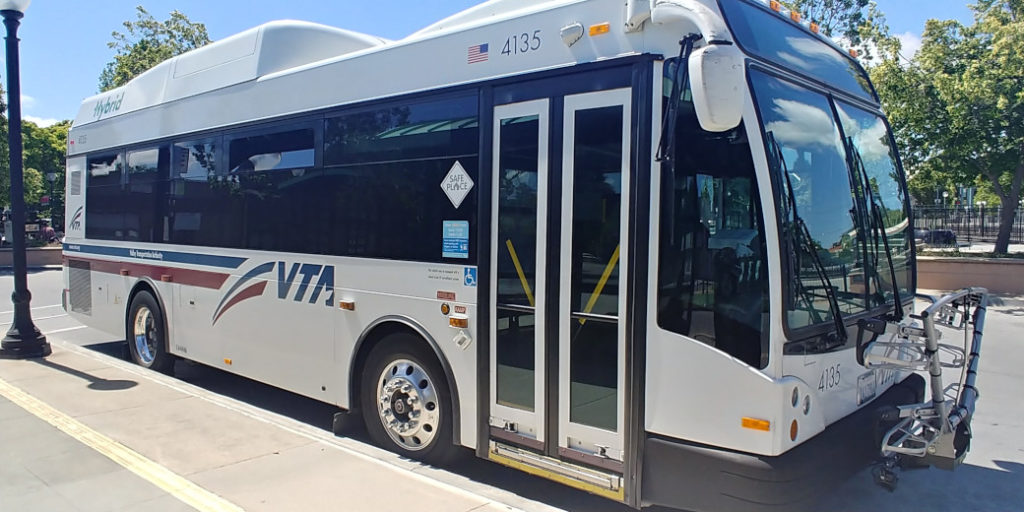
“Frequent” VTA bus service (bus route numbers 1-99; also applies to “Rapid” buses)
- share many of the same attributes as “Local” bus service
- run every 15 minutes or sooner on Mondays-Fridays from 6:30am-6:30pm
- run every 15-30 minutes on Saturdays, Sundays, and major holidays+
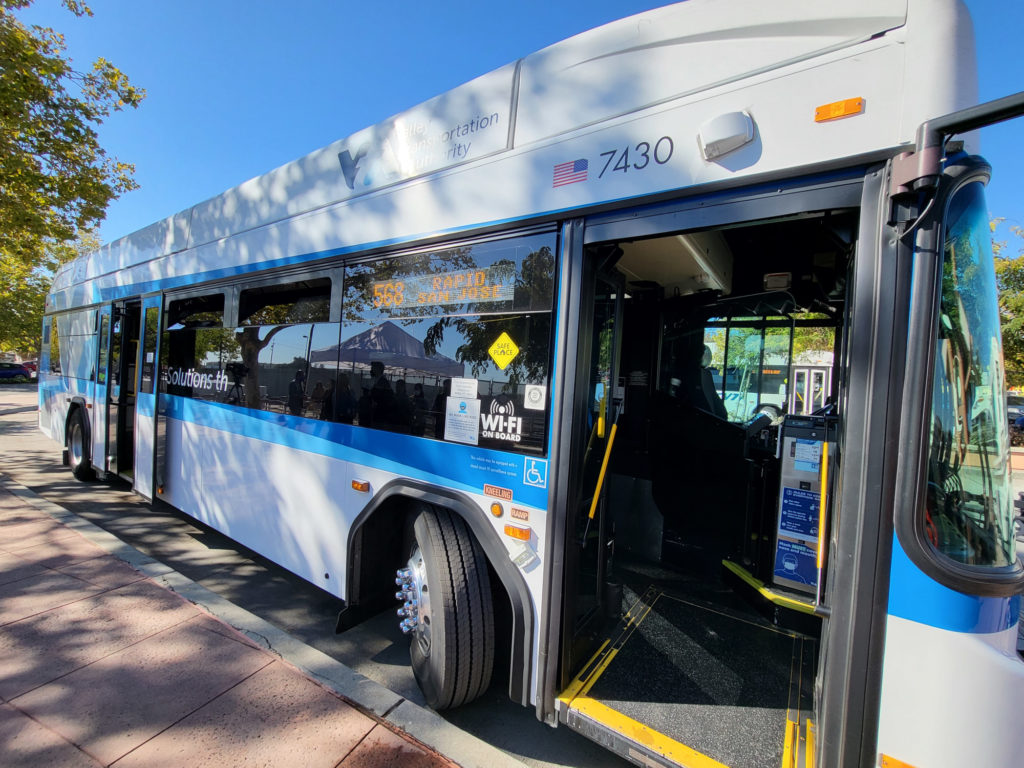
“Rapid” VTA bus service (bus route numbers 500-599 – often formerly known as “Limited Stop” bus service)
- has the same frequency as “frequent” VTA bus lines
- can leave bus stops up to 5 minutes earlier than scheduled time, as traffic allows
- make only a fraction of bus stops than local bus lines they run alongside (Example: 68 between SJ-Gilroy makes 95 stops, while the 568 Rapid bus between the same cities makes only 19 stops.)
- provide more timed & extensive connections at transit centers
“Express” VTA bus service (bus route numbers 100-199)
- adult fares are double that of standard VTA fares; Youth and Senior/Disabled passengers pay their standard fares
- run only on weekday peak periods. They do not run on weekends nor holidays.
- stop only at transit centers, industrial parks, park-and-ride lots, and major intersections
- operate to industrial parks in the morning only
- operate from industrial parks in the evening only
- operate mainly on freeways (state, Interstate, and U.S.) within Santa Clara County
- typically use “suburban style” buses that also have individual reading lights and Wi-Fi capability on-board
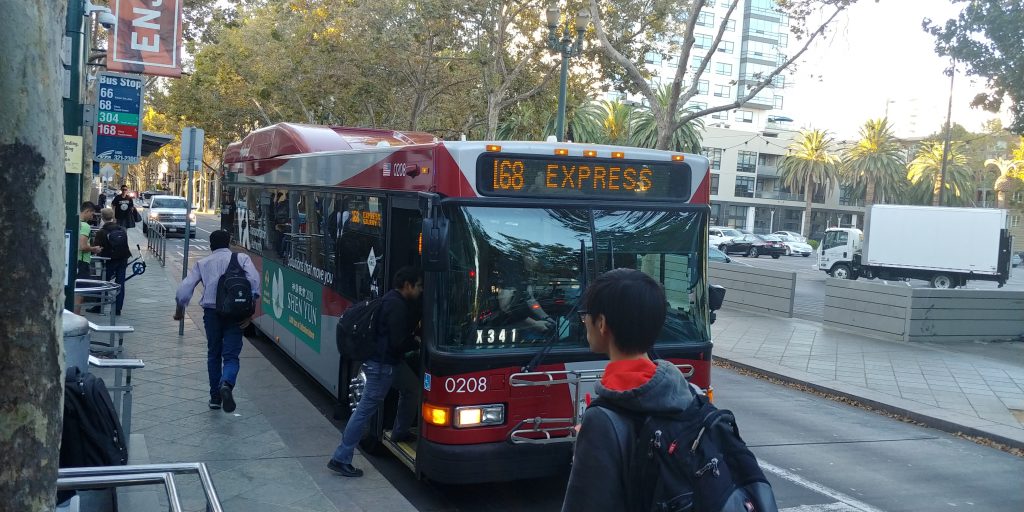
On school days, VTA “school trippers” are special services that typically operate to and from public elementary or high schools throughout Santa Clara County. Route numbers for school trippers are in the 200-299 range. School tripper service operates:
- to school in the morning
- from school in the afternoon after school dismisses for the day
- same service philosophy as “Local” bus service
How To Read a Bus Schedule
Here is a list of all current VTA bus and light rail lines, and their operating schedules.
All bus schedules are read from left to right. Most routes go in two directions (north/south or east/west). The origin and the destination are indicated in the timetables. Not all bus stops are listed on the schedule. The bus stops listed are called timepoints. The timepoints are also identified in the route maps.
A photo showing an example bus schedule is below.
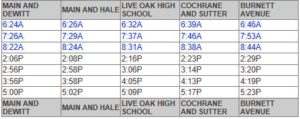
- Find the time point (column) for your starting point or closest to and before your starting point. For instance, you live one block from Main and Hale, so you would use the Main and Hale time point.
- Go down the column underneath the time point to find the time closest to when you want to catch the bus. Using the example bus schedule, you want to leave Main and Hale by bus at 2pm. However, the next bus is schedule to leave at 2:08pm.
- If you need to be somewhere by a certain time, find the time point closest to where you are going and what time the bus will arrive there. Work your way back to where you will begin your trip to find out what time you will need to get on the bus. For instance, you want to be at Burnett Avenue by 8:30am for an appointment. The closest time for bus arrival at Burnett Avenue is 7:53am. If you are taking the bus from Main and Hale, you would need to catch the bus due to depart Main and Hale at 7:28am.
We recommend arriving at a bus stop at least five minutes before the time shown on the timetable. This allows time to gather the exact fare or transit pass you will need to pay to board the bus.
At the Bus Stop…
VTA bus stops are marked by a blue sign on top of a metal pole. The blue sign will have the bus route number(s), operating frequency, and destination(s) posted on them. They also have VTA’s Customer Service telephone number for any questions you have on this or any other VTA bus or light rail service you wish to use.
Other public transit information, such as arrival times and service updates, is also available by dialing “511” from your mobile telephone. Dial in the five-digit ID number on the bus stop sign for information on arrival times and any delays for the bus you wish to take.
Some VTA bus stops have benches to sit on while you wait. Some VTA bus stops even have shelters to protect you from the elements while you wait.
Some examples of VTA bus stop signs are below.
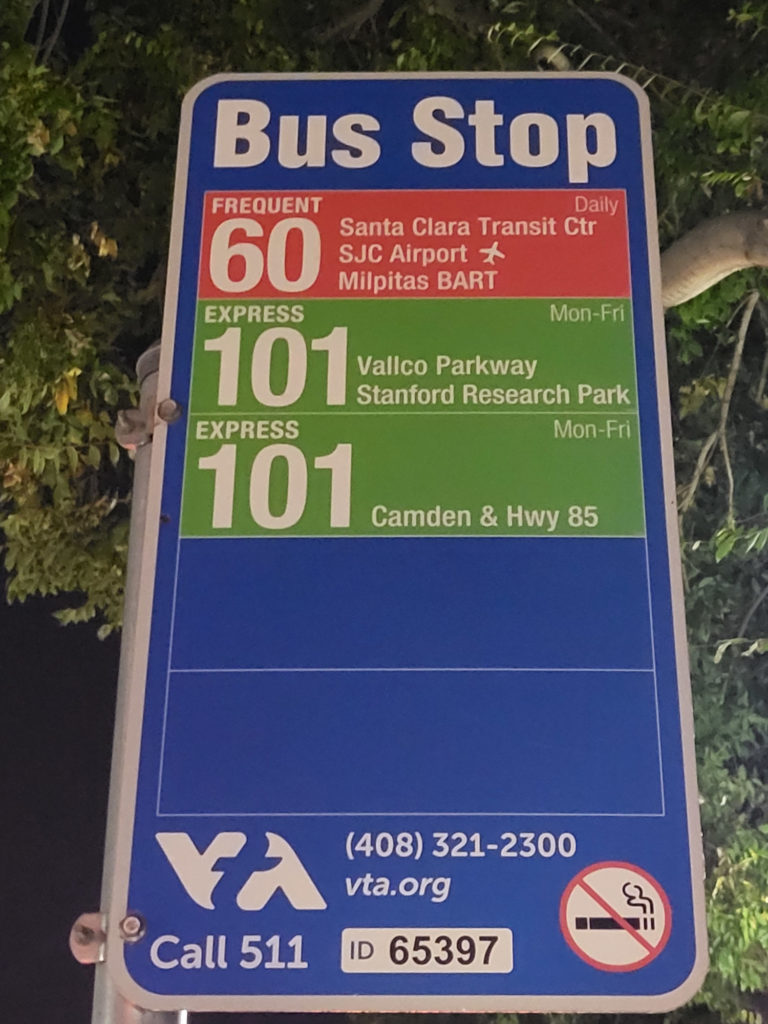
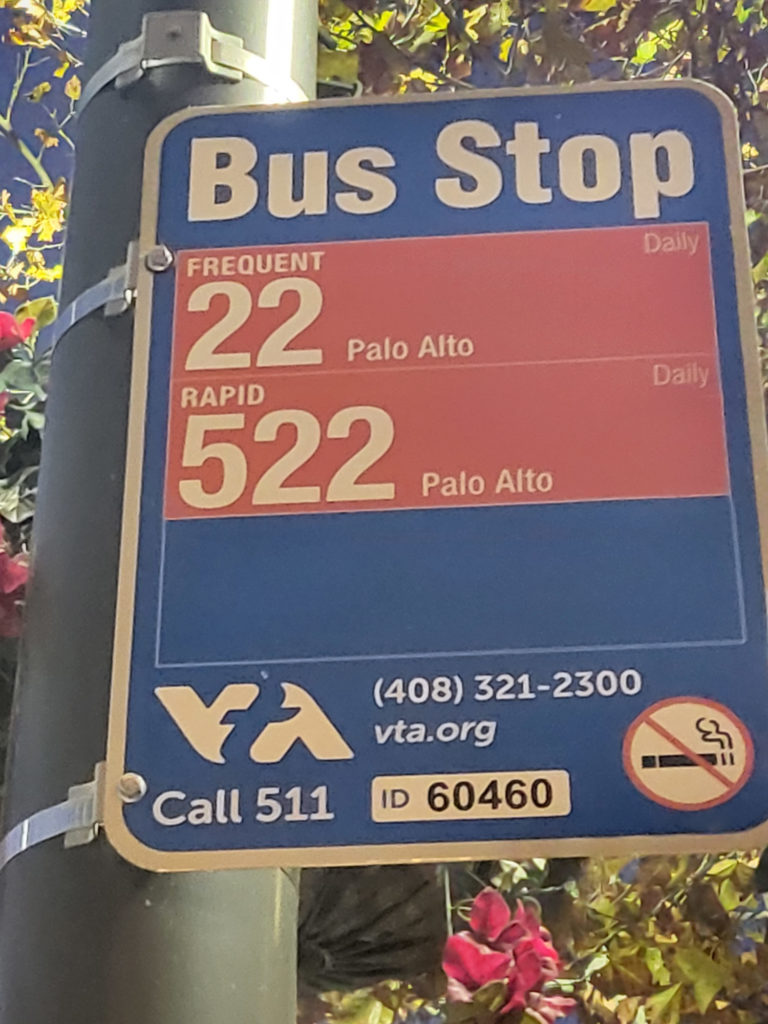
In other words…
- White text on a BLUE background – stop for a “local” bus line
- White text on a RED background – stop for a “frequent” or “rapid” bus line
- White text on a GREEN background – stop for an “express” bus line
Note that a VTA bus stop may serve more than one bus line. Also note: some VTA bus lines do not stop at all bus stops. It is important that you wait at the correct stop for the correct bus and direction you want to ride. See the above section explaining VTA bus service types, as of November 2021.
Major VTA bus stops and transit centers have electronic real-time boards showing the bus line and estimated time of the next arriving bus. A photo showing what one of these real-time bus arrival displays looks like is below.
The real-time bus arrival signs first show the current time and date. Then, it will scroll to show the bus line, final destination, and estimated time of arrival at the stop, up to one (1) hour later.
How To Board a VTA Bus
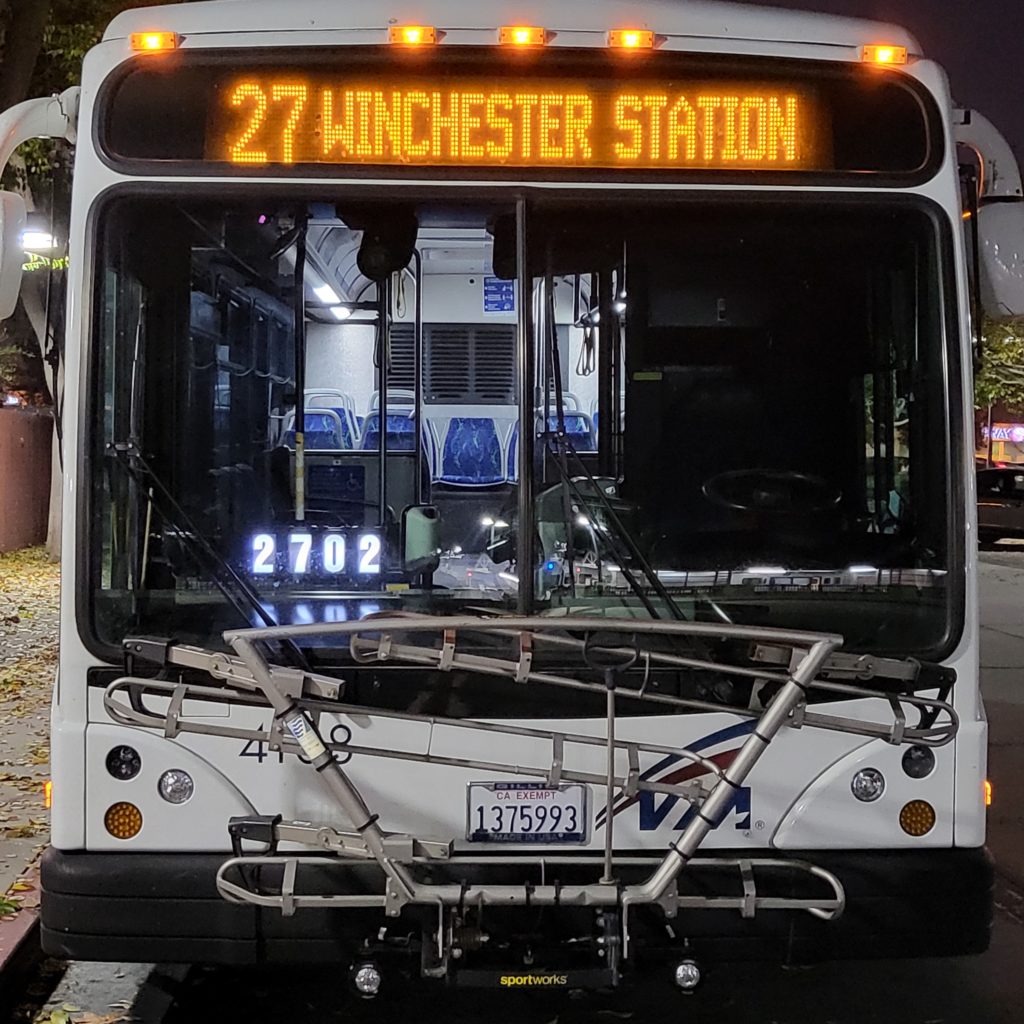
Every VTA bus has its line number and final destination displayed above the windshield, next to the front door, and on the driver’s side of the bus. The bus line number is always displayed at the right rear side of all buses.
Sometimes, VTA uses buses branded for certain bus routes or services on other routes, due to equipment availability. Make sure to check the front destination sign above the windshield for the correct bus and route. If you are still in doubt, ask the bus driver.
When you see an approaching bus with the correct route and destination, signal the driver by standing near the curb and pointing to the street with either your left arm or right arm. Wait until the bus comes to a complete stop before boarding through the front door.
Boarding a VTA Bus With Your Bicycle
Riding your bicycle and want to take a VTA bus to where you need to be? This video from VTA’s Bicycle and Pedestrian Advisory Committee from 2009 shows you how to load your bicycle on to the bike rack of any VTA bus.
As a courtesy, allow the elderly, the disabled, or pregnant women to depart the bus from the front door first. If there are any elderly, disabled, or pregnant women boarding the bus afterward, let these people board first.
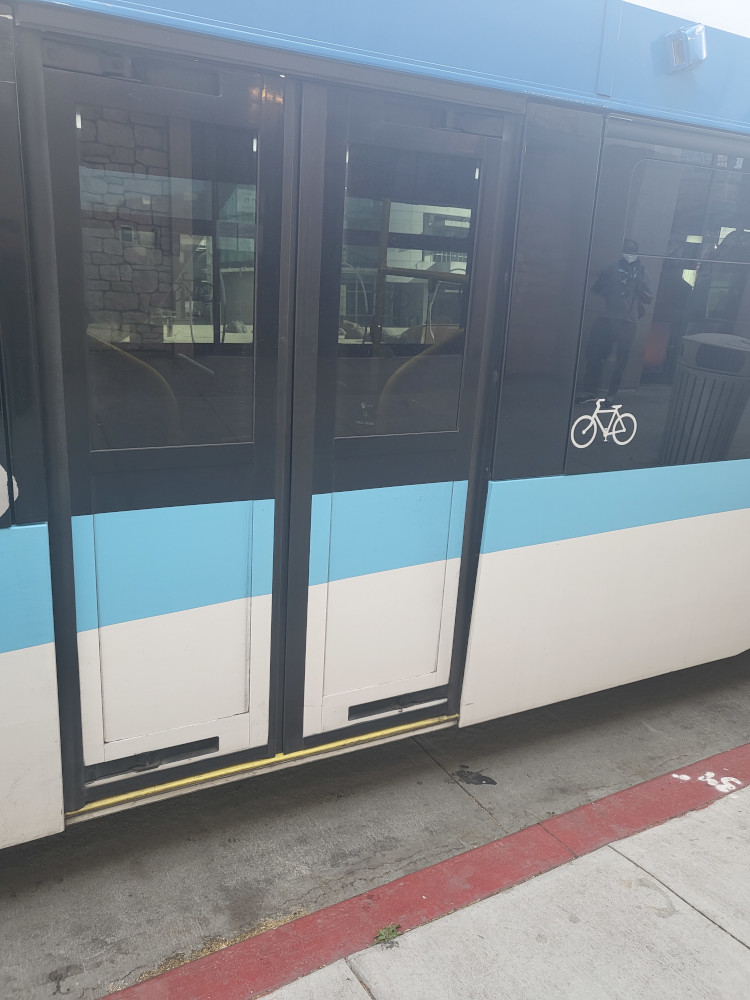
VTA 60-foot articulated buses have a second location to store your bicycle – at the back exit of the bus. To board such a bus, let the bus driver know you are boarding your bicycle at the rear of the bus. If you have cash or a paper pass, make sure to pay your fare at the farebox in front of the driver first. Otherwise, board with your bicycle at the back exit of the bus, tag your Clipper Card at the card reader on the right after you enter, and mount your bicycle on one of the two racks to the right as you enter the bus.
If you have a bicycle on the racks at the front of your VTA bus, let the driver know you have a bicycle in front of the bus, before you exit. This way, the bus driver can safely stop and allow you to remove your bicycle from the rack on the front of the bus.
How To Pay Your VTA Bus Fare
This chart details VTA bus fares by bus type, and age range. Pay your cash fare inside the fare box at the front of the bus. The photo below shows what a fare box aboard all VTA buses resembles.
VTA has a video detailing how to pay cash fare for the fare boxes aboard its buses.
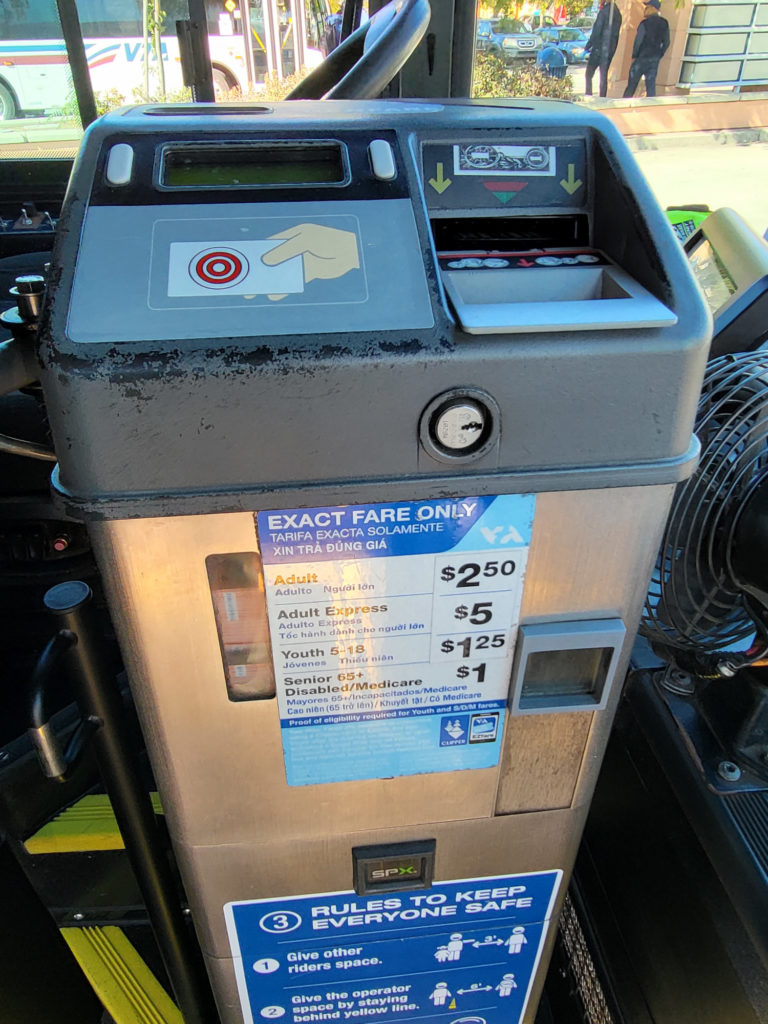
As of December 10, 2025, you can now pay for your VTA bus or light rail fare via your bank’s contactless debit card or credit card, on your card or mobile phone.Got a Clipper Card? “Tag” your Clipper Card in the blue area on the white Clipper Card reader aboard any VTA bus. On 35-ft. and 40-ft. buses, the Clipper Card reader is to the right of the fare box. On 60-ft. articulated buses, the Clipper Card reader is to your left, after you enter the bus’s front doors. A Clipper Card reader resembles the photo below.
After tagging your card, ensure the Clipper Card reader credits your fare before boarding the bus. This helps speed your bus trip and the trips of those aboard.
As of December 10, 2025, you can now pay for your VTA bus or light rail fare via your bank’s contactless debit card or credit card, on your card or mobile phone. Note that there are no more paper day passes available thru the fare boxes as of January 1, 2016. You will need to use your Clipper Card for these passes.
You can acquire a Clipper Card in any of the following ways:
- Ticket Vending Machines (TVMs) at any VTA light rail station
- select Walgreens stores in Santa Clara County
- other retailers in the San Francisco Bay Area
- For your Apple or Android smart phone or tablet, at the Apple Store or Google Play, respectively.
This video from VTA below explains how to purchase a Clipper Card from a VTA light rail ticket vending machine.
Basic Rules For Riding (Boarding) Any VTA Bus
After boarding the bus, move to the back of the bus and sit down in any available seat. If required to stand, please remain behind the yellow safety line and hold on to the hand rails provided, above the seats. Try to avoid crowding the front of the bus, especially when standing. This makes it difficult for those sitting to get off the bus at their stops, helping to slow things down.
The front of every VTA bus, behind the driver, has seats facing the aisle. As a courtesy, let seniors, the disabled, and pregnant women sit on those seats. As another courtesy, on crowded buses, offer your seat to a woman (especially a pregnant woman) or a senior. This makes their bus ride – and yours – more pleasant.
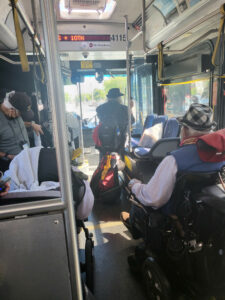
Here are additional rules of etiquette when riding any VTA bus for you to read and learn from. These rules of etiquette, when followed, allow a pleasant transit ride for you and others. Remember: you are riding on PUBLIC transportation.
How To Get Off (Alighting) From a VTA Bus
- VTA buses announce all upcoming bus stops on routes. Make sure to pay attention and listen for the bus stop you want to get off at.
- If you have the Transit “app” on your smart phone, make sure to pay attention to when your bus stop is coming up. Otherwise, If you have no idea on how your destination stop looks like, tell the bus driver where you want to get off.
- Immediately after your bus stop is announced, pull the bell cord or touch the yellow strip on the wall to alert the driver that you’d like to get off at the next bus stop. This will ring a signal chime and light a sign saying “Stop Requested” at the front of the bus. (A smaller “Stop Requested” light will also appear on the bus driver’s dashboard.)
- If able-bodied, leave the bus thru the rear doors. This helps shorten the time the bus is at a stop, ensuring the bus stays on time for other riders. Step as far away from the rear doors, taking all your belongings with you. Never step to the side of a bus’s rear doors – you could slip and fall under the wheels.
VTA Bus Transfers
Some of your trips may require you to take more than one bus line to reach your destination. Sometimes, you may need to transfer on to a light rail or commuter rail system to reach your destination.
If you already have a Clipper Card, here’s how VTA fare is charged between buses or light rail:
Transferring to Another Bus Line
When planning your trip, give yourself at least five (5) minutes’ lead time, between the time you arrive at the VTA bus connection’s stop, and the time your VTA connecting bus leaves that stop. This will give you time to reach the VTA connecting bus stop(s). Double that time if you are a senior, disabled, or carrying a lot of bags with you.
If you are taking a regional bus service like the Highway 17 Express Bus service, allow at least ten (10) minutes’ lead time to get to its bus stops either in downtown San Jose, or at San Jose Diridon Station.
Plan on riding an intercity service like Greyhound or Megabus? Allow at least 30 minutes’ lead time between the arriving VTA bus and scheduled departure for your intercity bus. This allows time for you to check yourself and any luggage you carry on to the bus. Help speed your intercity trip by buying your intercity bus ticket in advance.
Make sure to check the bus schedule(s) during your trip planning to allow for the best, fastest travel time between bus lines you will need.
Transferring to VTA Light Rail
Many VTA bus lines connect with the light rail system throughout Santa Clara County. As with connecting with VTA buses, plan your trip ahead of time, giving yourself at least five (5) minutes between when your bus arrives at the light rail station, and when the light rail train you want departs. Double that time if you are a senior, disabled, or carrying a lot of bags with you.
Transferring to Commuter or Intercity Bus or Rail Services
VTA buses and light rail serve Caltrain stations at Mountain View, San Jose Diridon, and Tamien light rail stations. VTA buses also stop at many stations along the Caltrain corridor in Santa Clara County, from Palo Alto to San Jose to Gilroy.
 Word From the Wise Word From the WiseA Caltrain monthly pass on a Clipper Card good for two or more zones also serves as a local monthly pass for VTA buses and light rail – including limited stop buses and rapid bus lines. Read up and wise up on this VTA and Caltrain bargain here. |
VTA buses and light rail also serve Capitol Corridor and Altamont Commuter Express stops in Santa Clara and San Jose Diridon. Riding Amtrak anywhere in the United States? VTA buses and light rail serve Amtrak’s only stop in Santa Clara County, at San Jose Diridon Station.
For all rail services except Amtrak, allow at least ten (10) minutes’ lead time between the time your bus arrives, and the time your connecting train departs the station. This will give you time to get to the station platform and buy your train ticket(s) if needed.
When taking Amtrak, allow at least one (1) hour between the time your bus arrives at San Jose Diridon Station, and your Amtrak train’s departure time. This gives you time to check in any baggage you have aboard the train, and to properly “check in” for the departing train as needed.
Know Before You Board
If you don’t know where your bus is going, ask the bus driver first before boarding. This way, you don’t end up on the wrong bus and stranded.
When riding the bus, if possible, avoid unnecessary conversations with the bus driver. While basic information is to be expected of the bus driver, that bus driver has two primary jobs: keeping the bus and its passengers safe and running the bus on time. In some cases, the bus driver may not be familiar with the area the bus is running through. It’s best to get the information you need for your trip before you depart. Read the previous section above for how to get this information.
How To Ride VTA Light Rail
Below is a map of the VTA Light Rail System, courtesy of VTA.
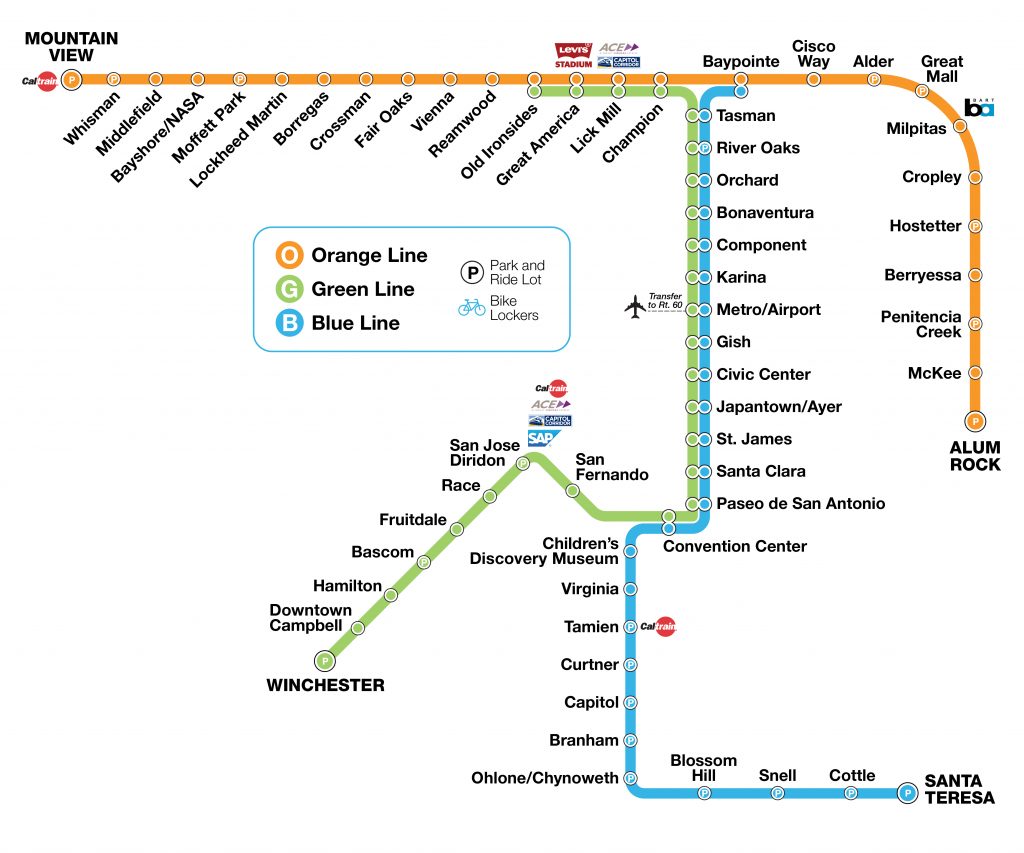
Light Rail stations have level platforms, signs, and shelters. Some stations have a center platform located between the two tracks, side platforms with two tracks in between, or a single platform with only one track. In downtown San Jose, northbound Light Rail trains run on 1st Street while southbound Light Rail trains run on 2nd Street.
FREE wireless internet (“Wi-Fi”) is available on all VTA light rail cars, and at the Winchester, Alum Rock, and Ohlone-Chynoweth light rail stations. Here’s how to use VTA’s public Wi-Fi network.
Reading the VTA Light Rail schedule
- Light rail schedules are read from left to right.
- Light rail routes go in two directions (north/south). The origin and the destination are indicated in the timetables.
- Not all stations are listed on the schedule. The stations listed are called timepoints.
- Find the timepoint (column) for your starting point or closest to and before your starting point.
- Go down the column underneath the timepoint to find the time closest to when you want to board the Light Rail.
- If you need to be somewhere by a certain time, find the timepoint closest to where you are going and what time the Light Rail will arrive there. Work your way back to where you will begin your trip to find out what time you will need to get on the Light Rail.
- We recommend arriving at a Light Rail station about five (5) minutes before the time shown on the timetable. If you are a senior or disabled plan on arriving at least ten (10) minutes before the time shown on the timetable.
Paying VTA Light Rail Fare
As of December 10, 2025, you can now pay for your VTA bus or light rail fare via your bank’s contactless debit card or credit card, on your card or mobile phone. If you don’t have a valid pass, make sure to purchase your ticket or pass before boarding. Ticket vending machines are available at all stations.
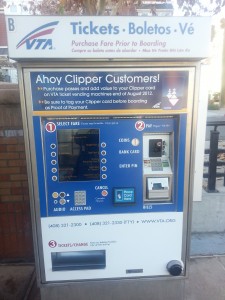
If you have a Clipper Card, make sure to “tag on” with your card at any of the black Clipper Card readers before boarding a VTA light rail train. The below photos show what a Clipper Card fare reader at a VTA light rail station looks like.
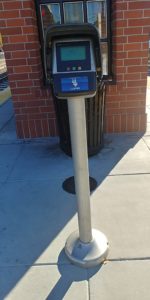

Failure to provide proof of payment to the fare inspector could result in a citation and fine of up to $276 or more.
The video from a light rail rider group below, shows you how to buy an 8-hour excursion pass (good for a round trip ticket) on VTA light rail.
A Clipper Card, when loaded with proper fare, simplifies transfers between light rail, VTA buses, other Bay Area transit agencies, and vice versa. This video from VTA below explains how to purchase a Clipper Card from a VTA light rail ticket vending machine.
At the VTA Light Rail Station
Many VTA light rail stations have shelters and benches to protect you from the elements. While waiting for your light rail train, stay behind the yellow line and away from the tracks.
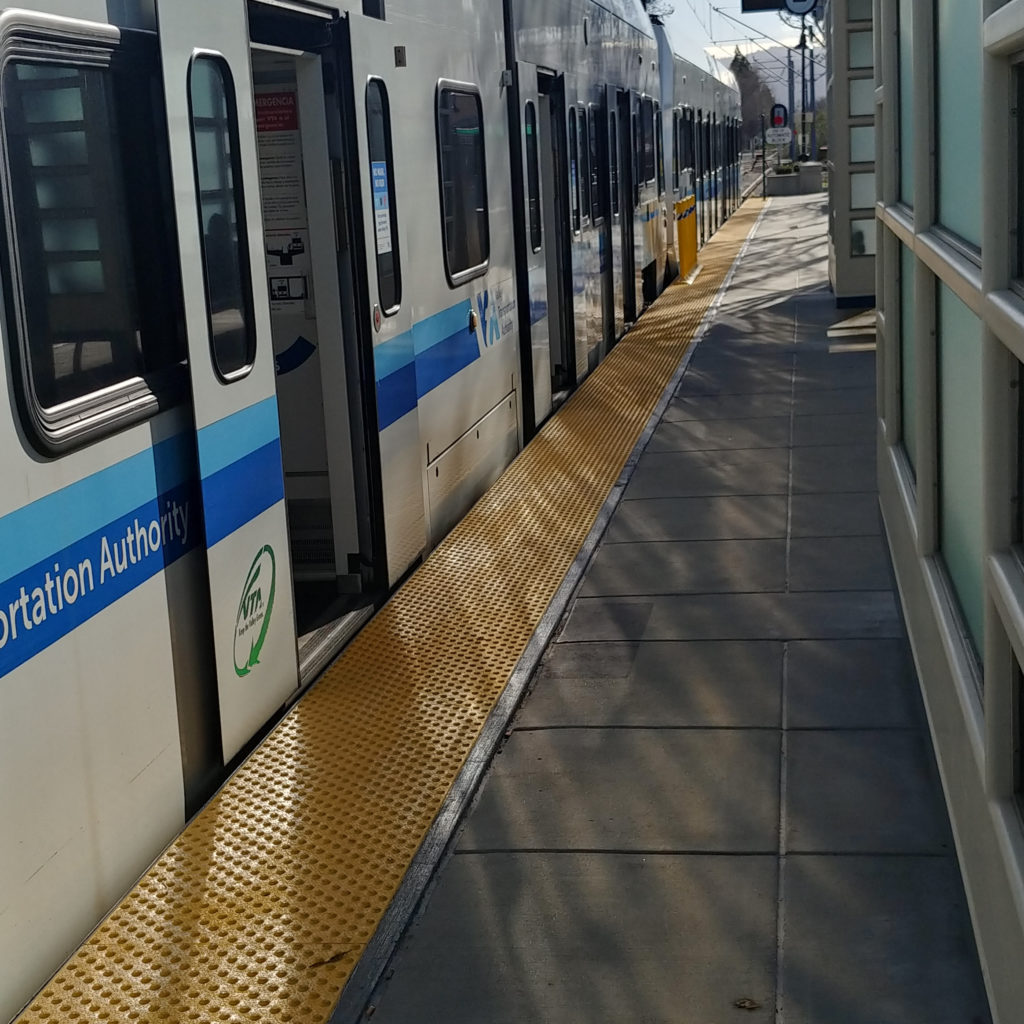
Like any other type of train, light rail trains can run on any track, at any speed, at any time. Light rail trains do not stop instantly; they often require long distances to fully stop.
Here are safety and security tips to help keep you safe at any VTA light rail station.
Every VTA light rail station has a television monitor indicating what line, destination, and when the next train will arrive.
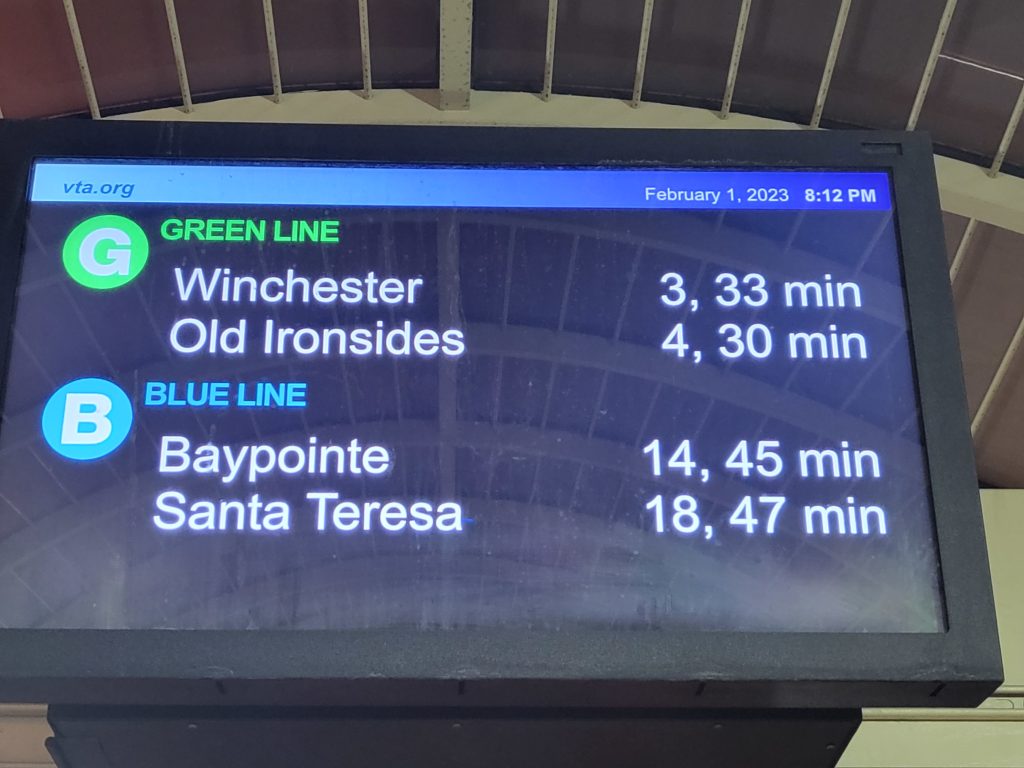
The monitors at each light rail station display the current date and time. They display what lines stop at each station and their estimated arrival time, up to one hour after the current displayed time. Where needed, the monitors also display system status and information on transit alternatives due to maintenance on the system, etc.
Boarding VTA Light Rail
As a light rail train approaches the station, make sure to look for the electronic destination signs. The signs and audio announcements will indicate the train’s final destination.
Read the signs on the platforms and by the tracks to make sure that you are waiting for the correct train.
Wait on the platform behind the yellow tactile warning band until the light rail car has come to a complete stop.
The light rail train operator will open doors automatically. Stand clear of the opening doors. After allowing those wishing to leave the train to do so, carefully enter the train. Take a seat or hold the handrails while the train is in motion.
When the four-tone sound plays, it means the doors are closing, and light rail is about to leave. Stand clear of closing VTA light rail doors. Do not block the closing doors of any VTA light rail train – otherwise, you will cause the train and others to be late.
Making Room For Other People Aboard VTA Light Rail
Here are some basic tips on how to make room for other people aboard VTA light rail.
Are you taking a bicycle with you aboard VTA light rail? Make sure to use the vertical bike racks at the center (bending portion) of any VTA light rail car. The photo below shows how to store your bicycle aboard any VTA light rail car.
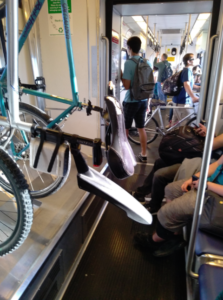
Courtesy @SwimPatricia on Twitter.
No room on the bicycle rack(s) for your bicycle? Place your bicycle underneath your seat. Do not place your bicycle (or anything else) in the aisle where it will block other passengers.
Occasionally, a VTA uniformed fare inspector may board the train and ask for a proof-of-payment. When asked, present your pass or ticket to the inspector.
To further help you safely board your bicycle aboard a VTA light rail car, we filmed our own video that shows you how. View that video below.
Exiting (Alighting) VTA Light Rail
- Listen to the automated announcement for the name of the next station. If you are about to get off at the next station, press the gray strip (located by the windows) before the train arrives at the station.
- If you have the Transit app on your smart phone, make sure you programmed the phone to tell you where your final destination is, and follow its instructions. Listen to the Transit app for when you need to get off light rail.
- Use caution when exiting Light Rail vehicles. The doors will stay open only a few seconds. As a courtesy, allow seniors, the disabled, or pregnant women to exit light rail first.
- Before exiting light rail, make sure to take any and all of your belongings with you.
VTA Light Rail Transfers
Often, you will need to transfer to a bus or even another type of train to reach your final destination. Below are some tips on how to simply light rail connections to buses and other trains.
As a reminder, here’s how VTA transfers between light rail lines and buses work, particularly if you have a Clipper Card:
Transferring to Another Bus Line
When planning your trip, give yourself at least five (5) minutes’ lead time, between the time VTA light rail arrives at your stop, and the time your VTA connecting bus leaves that stop. This will give you time to reach the VTA connecting bus stop. Double that time if you are a senior, disabled, or carrying a lot of bags with you.
Are you taking a regional bus service like the Highway 17 Express Bus service at San Jose Diridon Station? Allow at least ten (10) minutes’ lead time to get to the Highway 17 Express bus stop on the other side of San Jose Diridon Station.
Plan on riding an intercity service like Greyhound or Megabus? Allow at least 30 minutes’ lead time between the arriving VTA light rail train and scheduled departure for your intercity bus. This allows time for you to check yourself and any luggage you carry on to the bus. Help speed your intercity trip by buying your intercity bus ticket(s) in advance.
Make sure to check the VTA light rail schedule during your trip planning to allow for the best, fastest travel time necessary.
Transferring to Another VTA Light Rail Train
You can connect to another VTA light rail train line at two (2) stations in San Jose:
- Baypointe
- Convention Center
Check the VTA Light Rail schedule and allow at least ten (10) minutes for the connecting train. Listen on board the VTA light rail train for stop announcements, to help get you to your final destination.
Transferring to Other Transit Services
Sometimes, your journey may involve taking a local or regional (intercity) bus or train run by another company or agency. This portion of the guide will give you tips on how to handle such a transfer.
Commuter Rail and Intercity Rail
VTA buses and light rail serve Caltrain stations in Mountain View, San Jose, Tamien, Morgan Hill, San Martin, and Gilroy.
 Word From the Wise Word From the WiseA Caltrain monthly pass on a Clipper Card good for two or more zones also serves as a local monthly pass for VTA buses and light rail – including limited stop buses and rapid bus lines. Read up and wise up on this VTA and Caltrain bargain here. |
VTA buses and light rail also serve Capitol Corridor and Altamont Corridor Express (ACE) commuter trains in Santa Clara, and at San Jose Diridon Station.
Riding Amtrak intercity rail anywhere in the United States? VTA light rail serves Amtrak’s only stop in Santa Clara County, at San Jose Diridon Station.
For all rail services except Amtrak, allow at least 15 minutes’ lead time between the time your bus arrives, and the time your connecting train departs the station. This will give you time to get to the station platform and buy your train ticket(s) if needed.
When taking Amtrak, allow at least one (1) hour between the time your VTA bus or light rail arrives at San Jose Diridon Station, and your Amtrak train’s departure time. This gives you time to check in any baggage you have aboard the train, and to properly “check in” for the departing train as needed.
Commuter Bus, Inter-County Bus, and Intercity Bus
As of July 2019, VTA buses and light rail also connect with following commuter bus and intercity bus services, at San Jose Diridon Station:
- Amtrak Thruway
- Greyhound
- Megabus
- Monterey-Salinas Transit (55 and 86 bus lines to Monterey, King City, and Paso Robles)
- Santa Cruz Metro (Highway 17 Express, in cooperation with VTA and Amtrak California)
At the Palo Alto Transit Center, VTA buses also connect with bus services like
- SamTrans (San Mateo County Transit)
- Marguerite shuttle buses to/from Stanford University
- Dumbarton Express bus services to/from the East Bay
At the Gilroy Transit Center, VTA buses connect with bus services like
- Greyhound
- International Bus Lines (service throughout California, Tijuana, and Mexicali)
- Monterey-Salinas Transit (55 and 86 bus lines to Monterey, King City, and Paso Robles)
- San Benito County Express (Hollister and San Juan Batista)
Community Buses
In northern Santa Clara County, cities like Palo Alto and Mountain View have their own community shuttles. To supplement corporate employee shuttle buses in that city, Mountain View has an additional shuttle bus service. For those attending or working at Stanford University and related facilities, Marguerite Shuttle buses serves those areas. They typically connect with VTA and Caltrain at the transit centers in Palo Alto and Mountain View, respectively.
Connection Timing Rules Between VTA and These Buses
Timing rules of thumb to follow when connecting between these services and VTA:
For community bus lines and other bus lines serving local areas: allow at least 10 minutes lead time between arriving and departing connections.
For inter-county bus lines like Santa Cruz Metro, Dumbarton Express, and San Benito County Express: allow at least 15 minutes’ lead time between arriving and departing connections.
For intercity bus lines like Greyhound or Megabus: allow at least 30 minutes’ lead time between arriving and departing connections. This allows allows you time to check your bags in for departure, as needed.
Conclusion
We hope that this guide will give you some basics on how to ride and pay for your VTA bus or light rail trip. This should be especially useful if you are visiting Silicon Valley, or if you have just moved into Silicon Valley from elsewhere.
Please contact us for any questions or corrections to this guide. Your information will help others use public transit in Silicon Valley.
Eugene Bradley
Founder, Silicon Valley Transit Users
Michael, Marcia Cohen-Zakai, Monica Mallon, Thomas Mayer, and Judy Purrington contributed to this guide.
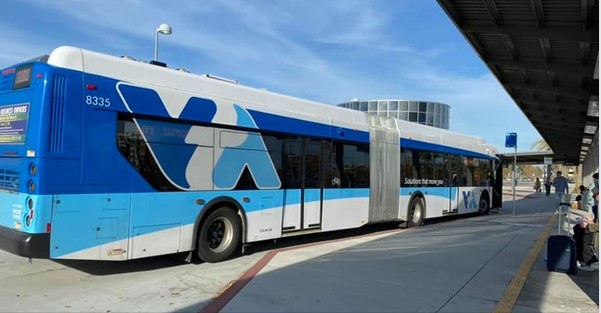
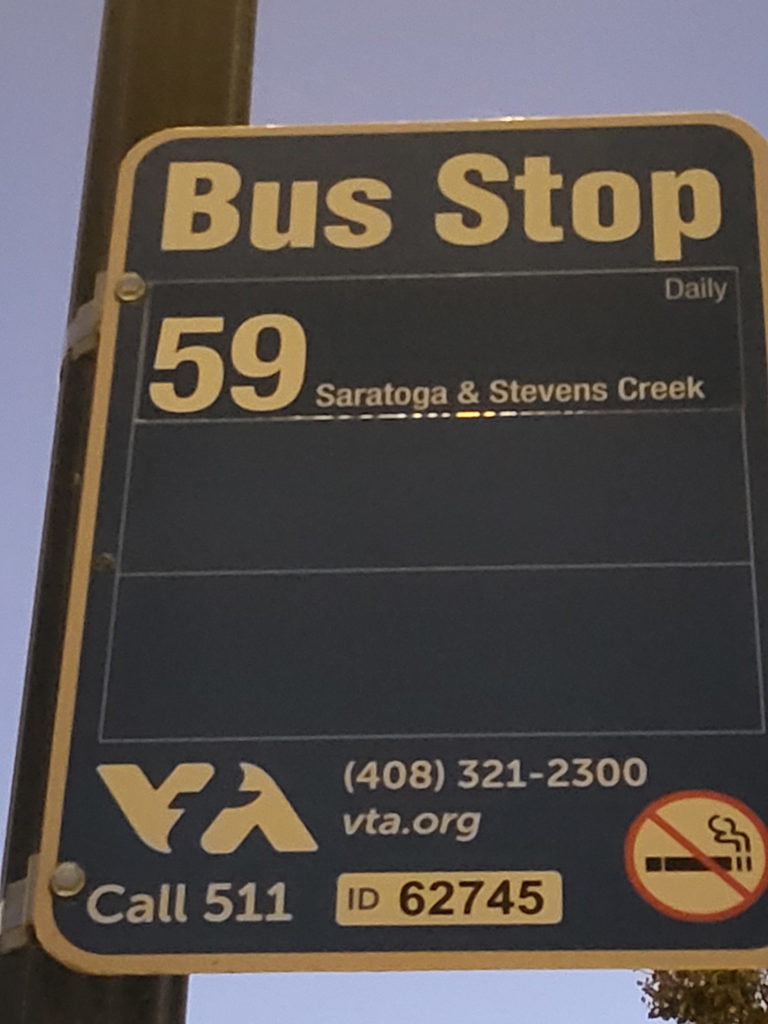
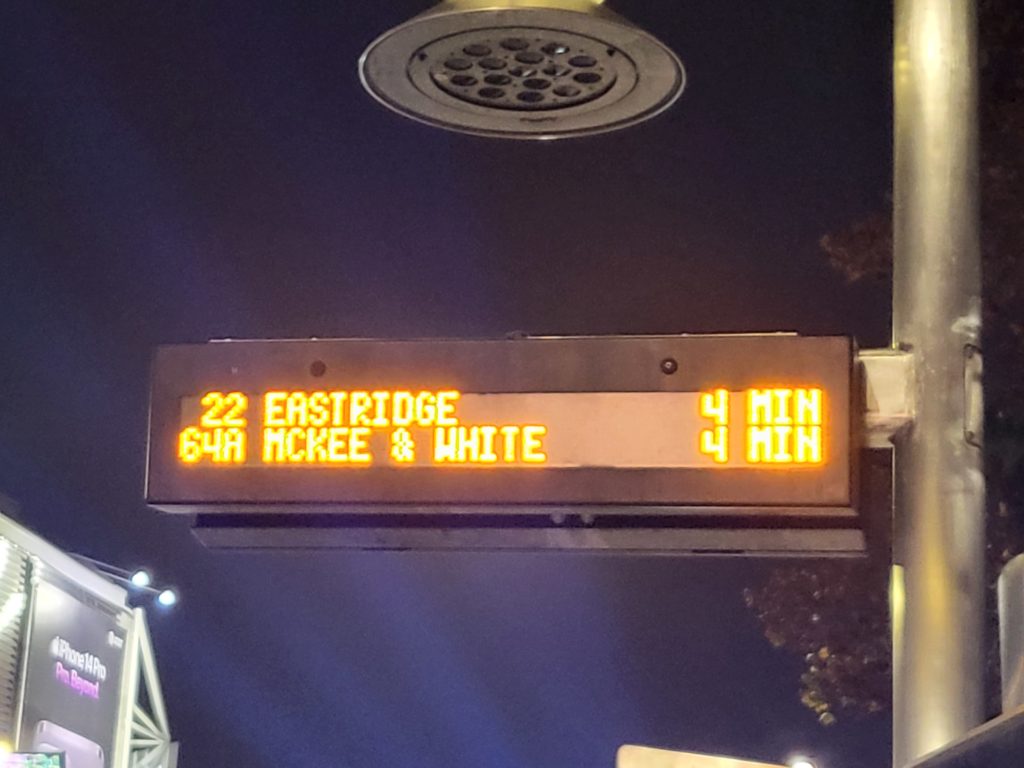
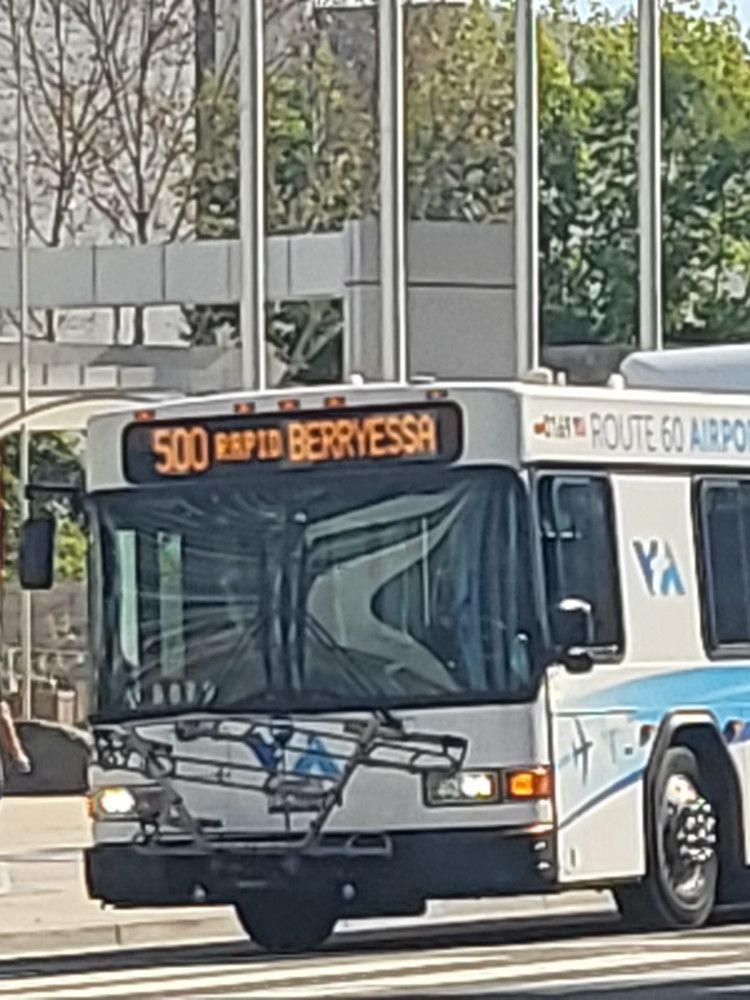
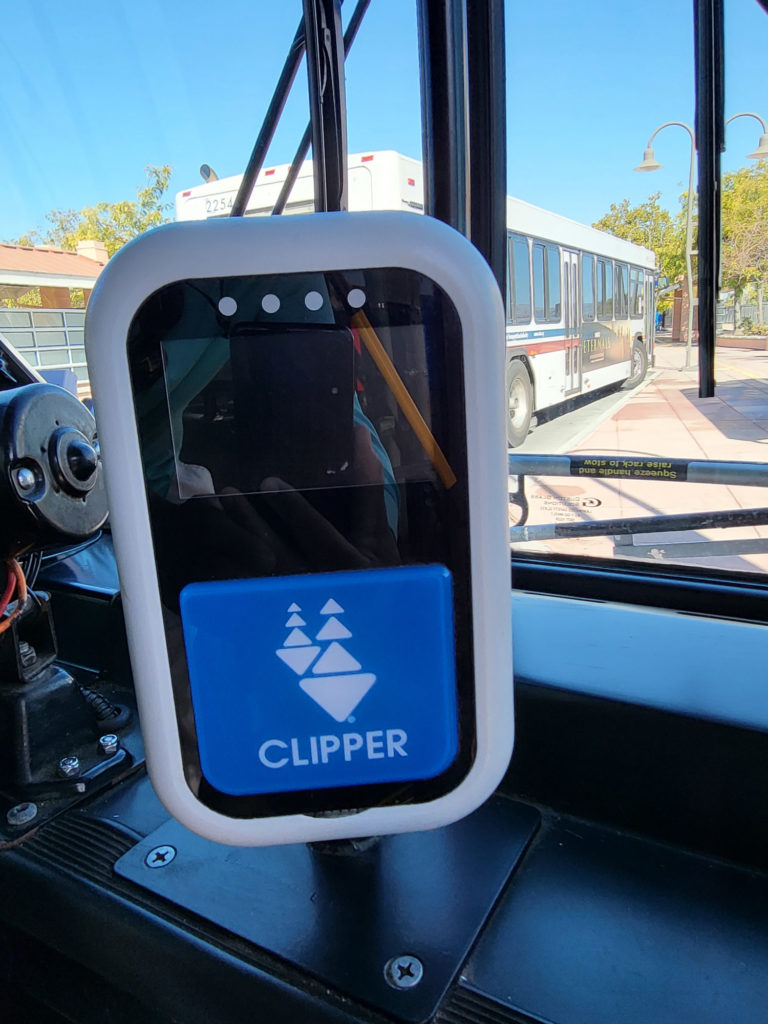
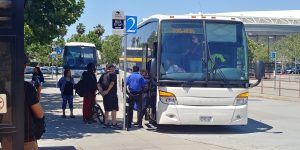

Super helpful article. Thank you
When going to a SJ Sharks game with a ticket, is it free to ride on light rail ??
DJ:
Currently, you still need proper, valid fare to ride light rail – even with a Sharks game ticket.
-Eugene